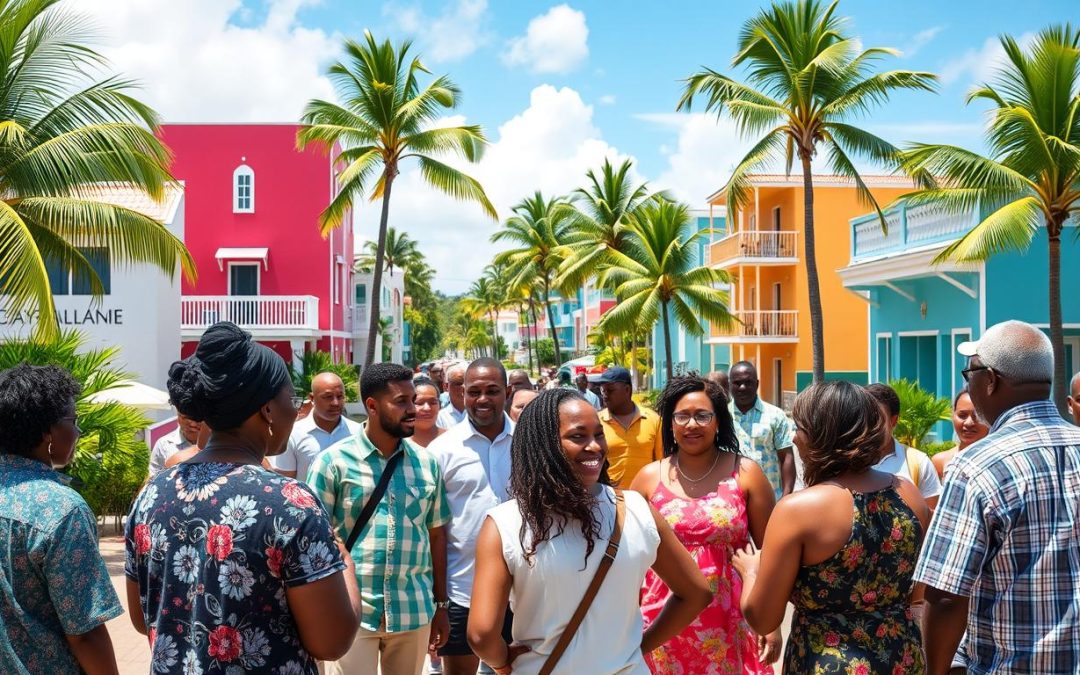Ever wondered how a small Caribbean group became a place where many languages meet? The Cayman Islands show a unique mix of languages, with English at its core.
In the Cayman Islands, English is the main language, spoken by 90% of people. This place is special because of its mix of cultures. People from over 140 countries live here.
Exploring the Cayman Islands’ language reveals a colorful world. English mixes with Spanish, Jamaican Patois, and more. This shows the islands’ vibrant culture and diversity.
Key Takeaways
- English is the official language of the Cayman Islands
- 90% of residents speak English as their primary language
- The islands host immigrants from over 140 countries
- Spanish is the second most frequently spoken language
- Linguistic diversity reflects the islands’ rich cultural heritage
Overview of Language Landscape in the Cayman Islands
The Cayman Islands have a unique language scene. It shows a rich cultural mix. Here, you see how different cultures blend through language.
Historical Language Development
The Cayman Islands’ language history starts with early European settlers. People from England, Scotland, and Wales came first. They brought their languages, which mixed to create Cayman Creole.
This Creole is special. It combines parts from many European languages.
- European settler languages formed the foundation
- Creole emerged as a distinctive communication method
- Caribbean languages influenced local speech patterns
Current Language Demographics
Now, the Cayman Islands are full of life in language. English is the official tongue, but you’ll find many other languages too. This shows the islands’ diverse culture.
“Language is the road map of a culture. It tells you where its people come from and where they are going.” – Rita Mae Brown
Language Distribution Across Islands
Grand Cayman, Cayman Brac, and Little Cayman each have their own language styles. Urban and rural areas also have different ways of speaking. This shows the islands’ varied culture.
Exploring the Cayman Islands’ languages is exciting. It shows a world that’s always changing. This world reflects the area’s deep cultural diversity.
English as the Official Language
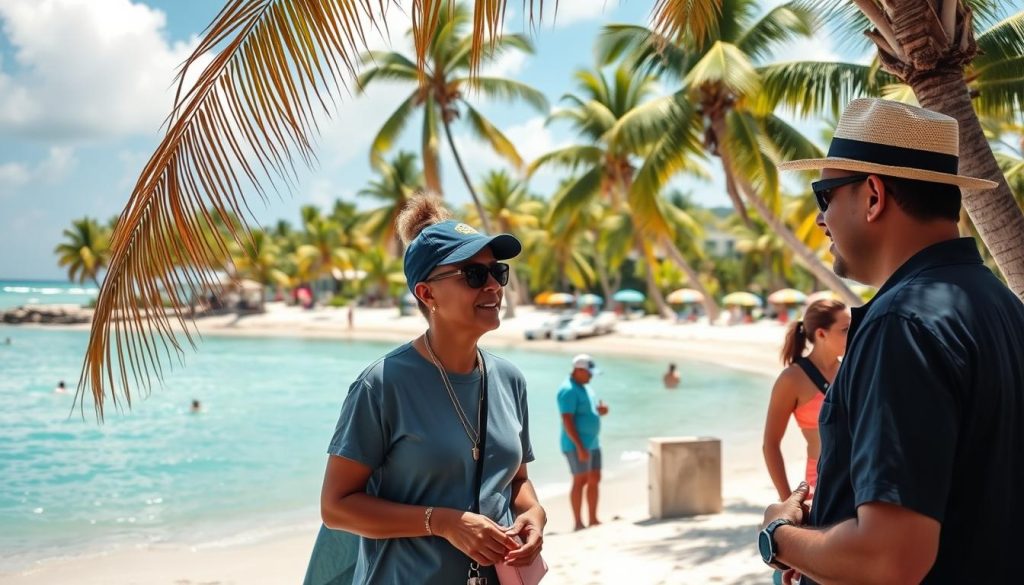
The English language is key in the Cayman Islands. About 90% of Caymanians speak English, making it a lively part of their culture.
Caymanian English is more than just a dialect. It’s a mix of history and culture in words. It has its own special features, different from standard English.
- Early Modern English
- Caribbean Creole languages
- West African linguistic influences
- British regional dialects
Linguists have found interesting details in Caymanian English. They note how it uses broad English sounds and unique pronouns.
“Language is the road map of a culture. It tells you where its people come from and where they are going.” – Rita Mae Brown
The official language helps keep the islands’ culture alive. It shows a journey of language, mixing many influences.
Learning Caymanian English helps visitors and researchers understand the islands better. It’s used in government and daily talks, showing Caymanian identity.
Official Language Policies and Practices
The Cayman Islands have a strong language policy that shows its international character. It’s a global financial center with a rich mix of cultures. The territory’s language approach is more than just talking.
English is the main official language in the Cayman Islands. The government has set up language practices that support many languages. But they also make sure everyone can communicate clearly.
Government Language Policies
The Cayman Islands government uses language policy to help with international business. Key points include:
- English as the main language for government work
- Support for many languages in public services
- Official documents in English
Educational System Language Requirements
Language education in the Cayman Islands focuses on English skills. The schools have programs for learning English:
- English is the main way of teaching
- Students must show they can speak English well
- They can also take courses in other languages
Business Communication Standards
With 118,443 active companies, business communication needs to be clear. The territory’s language practices help with:
| Communication Aspect | Language Standard |
|---|---|
| Corporate Documentation | English Proficiency Required |
| International Negotiations | Multilingual Capabilities Preferred |
| Customer Service | English Fluency Mandatory |
“Language is the roadmap of a culture. It tells you where its people come from and where they are going.” – Rita Mae Brown
Knowing these language policies helps you move around the Cayman Islands better. It’s good for work and social life.
Cayman Creole: A Unique Linguistic Heritage
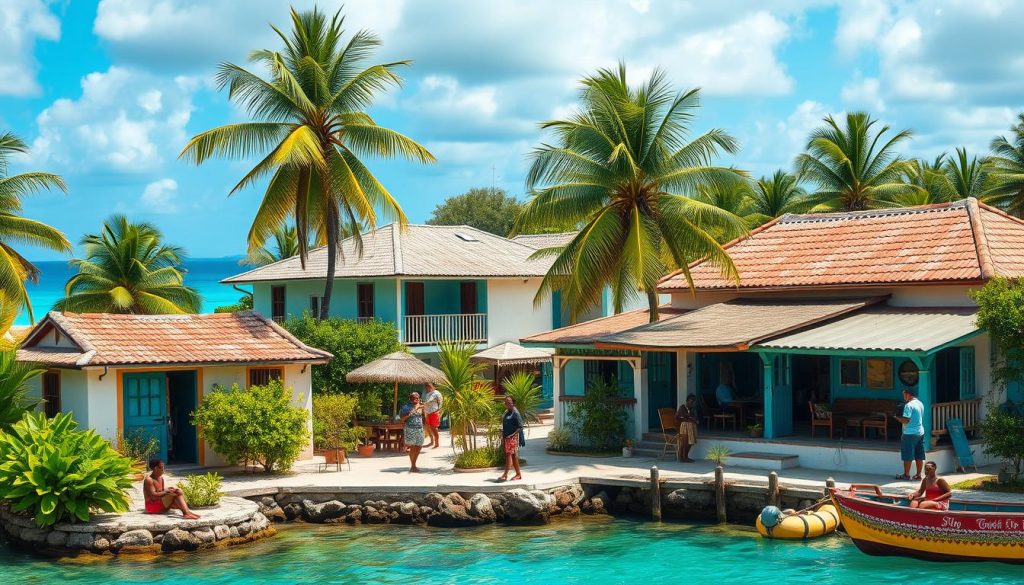
Cayman Creole is a special part of the Caribbean dialects. It’s not a separate language but a special way of speaking English. This shows the rich culture of the Cayman Islands.
The history of Cayman Creole is complex. It comes from the mix of early settlers, African people, and sailors. This mix shaped how people talk in the islands.
“Language is the road map of a culture. It tells you where its people come from and where they are going.” – Rita Mae Brown
What makes Cayman Creole unique includes:
- Distinctive pronunciation patterns
- Unique vocabulary from different cultures
- Grammar that’s different from standard English
- A strong tradition of speaking that keeps language alive
Even though Cayman Creole might sound strange to outsiders, it’s very important to locals. It shows their pride and keeps their community together.
Learning about Cayman Creole helps visitors and researchers understand the islands better. It’s not just a way to talk. It’s a sign of the Caymanian people’s strength and culture.
Spanish Language Influence and Usage
The Cayman Islands are a lively mix of languages, with Spanish becoming more important. About 10-12% of people speak Spanish, making the Hispanic community a big part of the culture.
Hispanic Community Impact
Spanish speakers are a key part of the Cayman Islands’ society. The Caribbean way of speaking Spanish adds depth to the community. People from Hispanic backgrounds work in many fields, from tourism to professional services.
- Approximately 10-12% of population speaks Spanish
- Predominantly Caribbean Spanish dialect
- Growing influence in multiple professional sectors
Spanish in Business and Tourism
Knowing both English and Spanish is very useful in the Cayman Islands. Businesses see the value of Spanish skills, especially in tourism and international trade. Many companies look for employees who can speak Spanish.
“Language is the roadmap of a culture. It tells you where its people come from and where they are going.” – Rita Mae Brown
Cultural Integration
Spanish and Hispanic culture add to the Cayman Islands’ rich mix. Schools and community groups are working to support language diversity and understanding between cultures.
Visiting the Cayman Islands will be more rewarding if you appreciate the Spanish-speaking community. Their contributions make the islands’ culture truly unique.
Jamaican Patois in Caymanian Culture
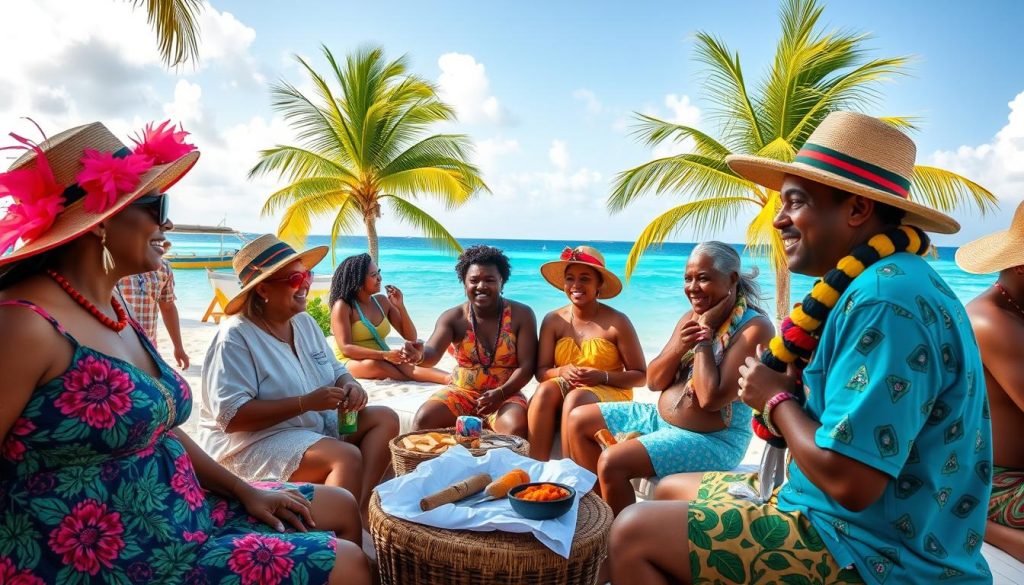
Jamaican Patois has become a big part of Caymanian culture. It mixes with other Caribbean languages, showing the islands’ rich history. This vibrant language is loved by the Jamaican community in the Cayman Islands.
In the Cayman Islands, Jamaican Patois is more than a way to talk. It connects families and communities across generations. It adds flavor to everyday talks, music, and sayings.
“Language is the road map of a culture. It tells you where its people come from and where they are going.” – Rita Mae Brown
- Jamaican Patois came from African, English, and Indigenous languages
- Young Caymanians often use Patois in their speech
- The dialect shows the strong bond between Jamaica and the Cayman Islands
Jamaican Patois’s impact goes beyond just talking. It’s seen in local music, arts, and events. These show the lively language heritage that’s key to Caymanian identity.
| Language Characteristic | Impact on Caymanian Culture |
|---|---|
| Linguistic Diversity | Enriches communication and cultural expression |
| Historical Connections | Strengthens ties between Jamaican and Caymanian communities |
| Cultural Identity | Provides unique linguistic markers of local heritage |
Jamaican Patois is more than a language in the Cayman Islands. It’s a living part of the islands’ rich culture. The dialect keeps changing, showing the lively spirit of Caymanian society and its Caribbean roots.
Emerging Languages in Modern Cayman Society
The Cayman Islands are a colorful mix of languages, showing the unique culture of this Caribbean spot. With more international workers coming in, the language scene has changed a lot lately.
Immigrant languages add depth to the Cayman Islands’ way of talking. Being able to speak many languages is now a big part of life here. It helps people understand each other better.
Filipino Community and Tagalog
Tagalog is becoming a big language in immigrant groups. About 5% of people speak Tagalog, mostly Filipino workers in services and hotels. They help make the islands more lively and diverse.
- Estimated Tagalog speakers: 5% of population
- Primary sectors: Service industry, hospitality, healthcare
- Integration challenges: Language barriers, cultural adaptation
Other Minority Languages
There are many other languages in the Cayman Islands too. People from all over speak:
- Chinese dialects
- Arabic
- Hindi
- French Creole
Immigrant Language Integration
Learning languages is more than just talking—it’s about connecting. Schools and businesses are starting to see the value of different languages. They’re creating programs for learning and sharing cultures.
“Language is the roadmap of a culture. It tells you where its people come from and where they are going.” – Rita Mae Brown
The Cayman Islands are growing into a place where many languages are welcome. They see the good that comes from having different languages in their community.
Language Education and Learning Resources
The Cayman Islands boast a rich landscape of language education. It reflects the area’s diverse multilingual heritage. Your language learning journey here can be both thrilling and all-encompassing, with many paths to enhance your linguistic skills.
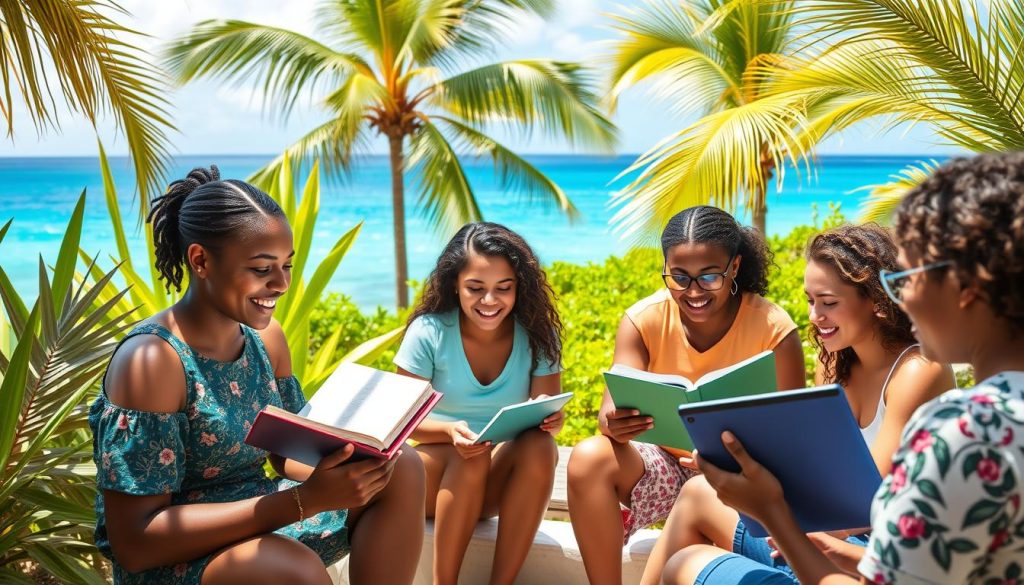
Language education in the Cayman Islands blends traditional and modern methods. This meets the varied needs of learners. Local schools and institutions offer structured language learning resources for all skill levels.
- Public schools with bilingual curricula
- Private language centers with specialized programs
- Online learning platforms
- Cultural exchange workshops
The educational system uses Content and Language Integrated Learning (CLIL) strategies. These have shown to boost multilingual skills. Studies show bilingual students have better memory and focus.
“Language learning is not just about communication, but about understanding cultural perspectives” – Local Education Expert
For adults looking to learn a new language, the Cayman Islands have plenty to offer. Community centers, professional training, and digital platforms provide flexible learning spaces. These support ongoing language growth.
- English proficiency courses
- Spanish language programs
- Professional communication workshops
- Intensive language immersion experiences
Whether you’re a student, professional, or language lover, the Cayman Islands’ language education scene is vibrant. It offers engaging opportunities to broaden your language skills.
Impact of Multilingualism on Tourism and Business
The Cayman Islands show how multilingualism boosts the economy. Understanding language can reveal how it improves tourism and business.
Multilingualism is key to the Cayman Islands’ economic growth. The local workforce’s language skills give them a big edge in many areas.
“Language is the passport to a world of opportunities” – Unknown
- Tourism gets a big boost from multilingual interactions
- Business talks become more detailed and welcoming
- International visitors get better service
Numbers show the economic benefits are real. Being multilingual can open up to 25% more business opportunities in tourism areas. Companies with multilingual staff see about 15% more sales because of better communication and more market access.
| Language Capability | Business Impact | Percentage Increase |
|---|---|---|
| English Proficiency | Global Business Communication | 45% |
| Spanish Language Skills | Tourism Engagement | 30% |
| Multilingual Workforce | Sales Potential | 25% |
Adopting multilingual strategies can greatly help your business. By valuing diverse language skills, you’ll make the Cayman Islands’ economy more vibrant and flexible.
Conclusion
The Cayman Islands are known for their rich language diversity. This diversity shows the islands’ vibrant culture. You’ll find a mix of English, Cayman Creole, Spanish, and more, which shapes how people communicate here.
This language mix is more than just a way to talk. It shows the islands’ diverse culture. It’s a key part of who they are.
The islands’ language scene is complex but strong. It helps their tourism and finance industries grow. About 60% of people here are multiracial, making the language scene a mirror of their society.
Learning about the Cayman Islands’ languages helps us see their economic and social success. Being able to speak many languages makes the islands welcoming to businesses and visitors. Exploring the islands’ languages shows how they connect cultures and boost the economy.
The Cayman Islands are a great example of language diversity’s power. Whether you’re into culture, business, or global communication, the islands offer a unique view into a diverse culture.
The above is subject to change.
Check back often to TRAVEL.COM for the latest travel tips and deals.
Here are some Tours & Sightseeing suggestions that might pique your interests!
